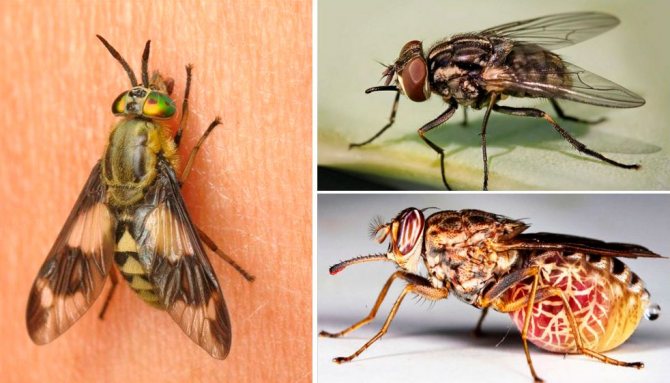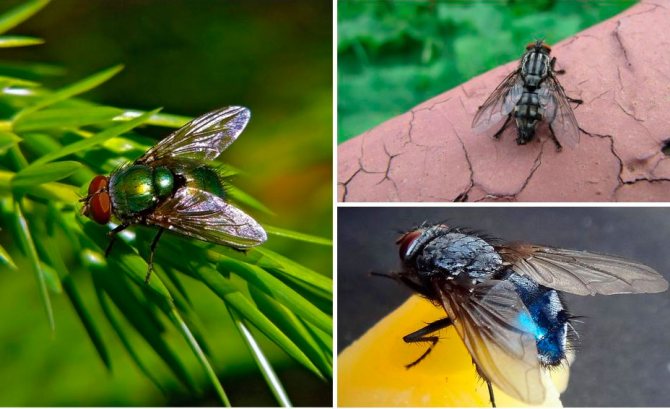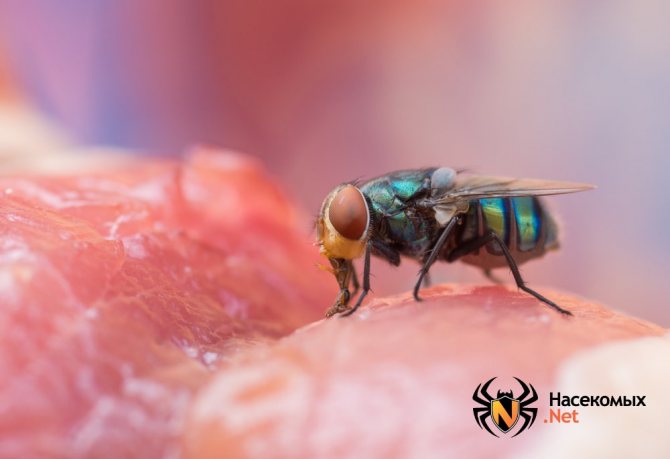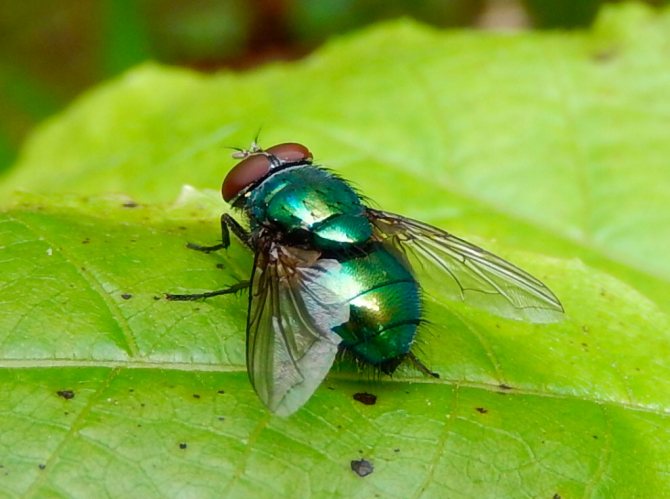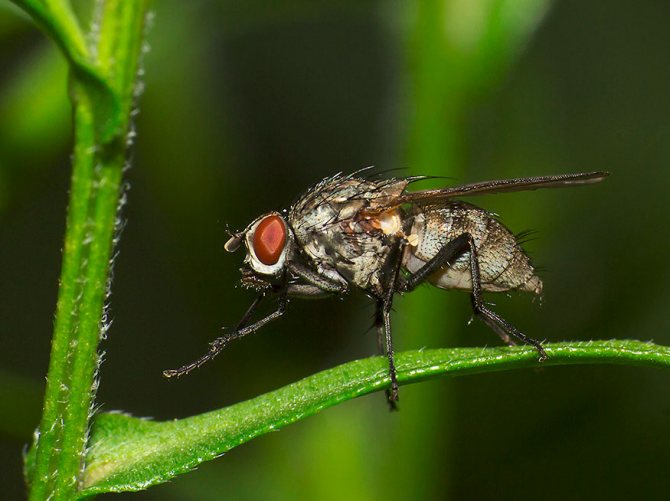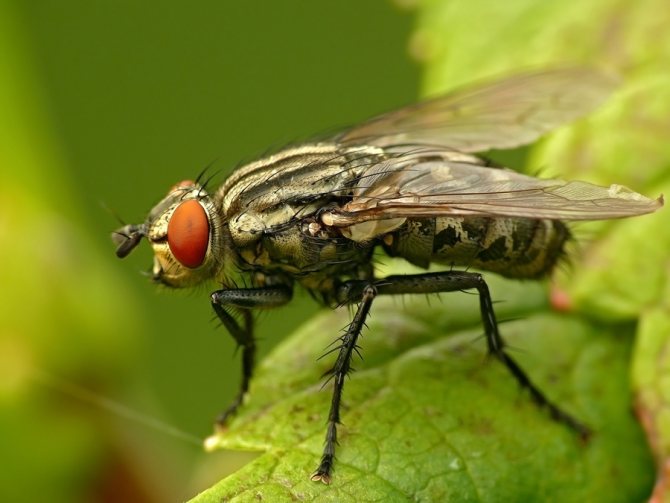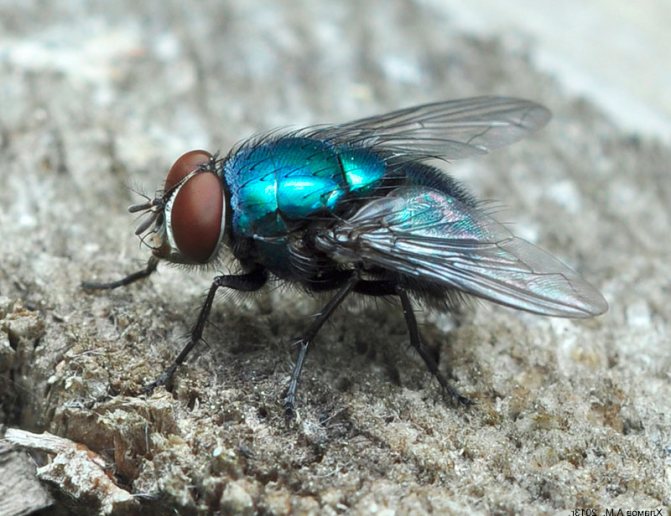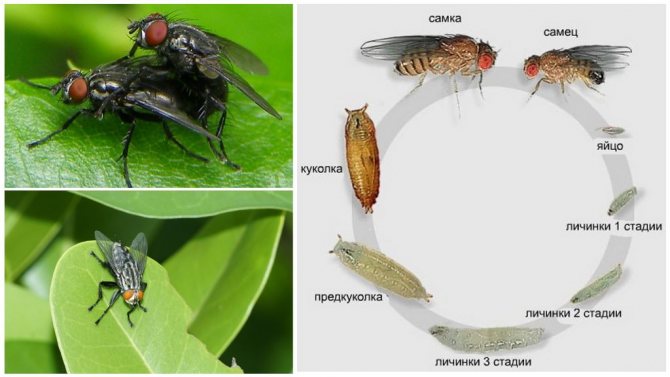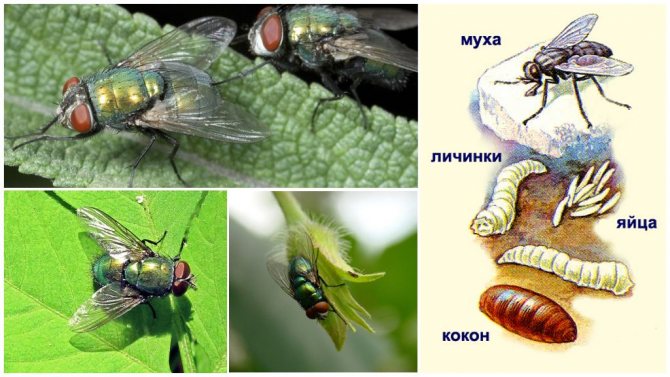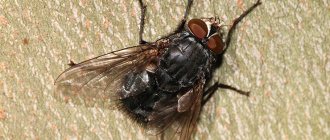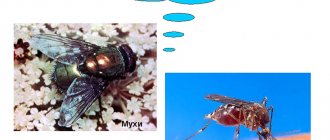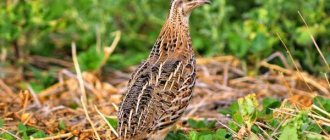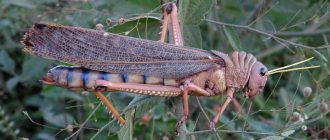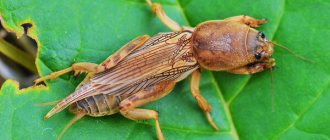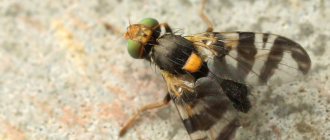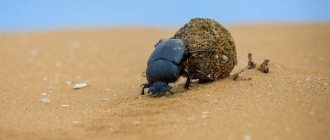If the title can confuse someone, then we explain the following. The meatfly lays the larvae, which are often used and demanded by humans. Of course, this primarily applies to fishermen, who rarely go to water bodies without maggots.
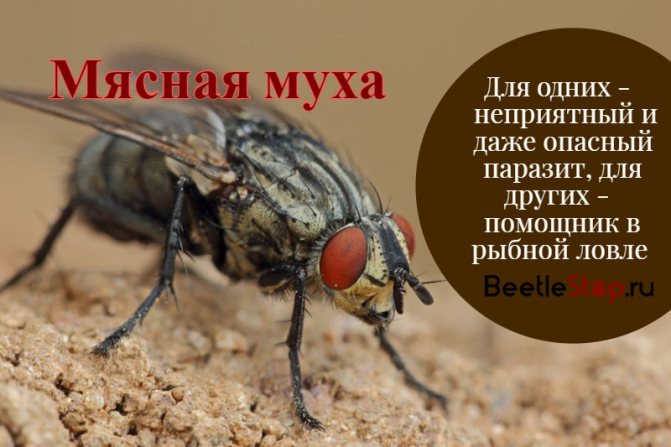
The second use of the fly fly larva was found in military medicine. In conditions of a lack of medicines, decaying wounds were treated with maggots. Here, the property of the larvae was used to eat dying tissue and not touch the living one. Several maggots were planted in a decaying wound, and after a while they made it clean.
Meat family
This family includes over two thousand species. They are found mainly in the northern hemisphere, in areas with a temperate climate. In hot climates, there are not so many of them.
Mostly the fly is gray in color, but other colors are also found. Some species are quite large, their length can reach more than two centimeters, but there are also small ones - no more than six millimeters. The larvae of these flies usually develop on rotting meat or other organic matter. There are meat flies that lay eggs in other insects, injured animals, and even humans.
There are viviparous meat flies that deposit larvae in a decaying corpse.
Treatment
Many diseases carried by blowflies have specific treatments. For many, special vaccines have been developed. And yet, the main disease carried by meat flies is myiasis, about the treatment of which we will tell you in detail.
Since myiasis can be both internal and external, their treatment is different. If the skin is damaged, it is necessary to wait for the maturation of the larva, after which it approaches the outside and it is easy to remove it from the wound with tweezers. To accelerate the advancement of the larva, you can use various oils: vegetable, camphor, petroleum jelly, or those that you have at home. The oils prevent oxygen from entering, thereby provoking the larva to move outward. After the larva has been removed, the wound must be treated with an antiseptic and a sterile compress with a disinfectant must be applied; in case of significant damage, external or systemic antibiotics can be prescribed. And in no case, you should not try to remove the larva before it approaches the exit, this can lead to its rupture and suppuration of the wound. In case of damage to internal organs, intestines, antiparasitic drugs are used; if it enters the stomach, it is washed.
Housefly
Some people mistake the common housefly for a meatfly, but this is not true. The house fly is much smaller, and it is not able to bite through the skin, it feeds only on liquid food, and it must first dissolve solid food in saliva.
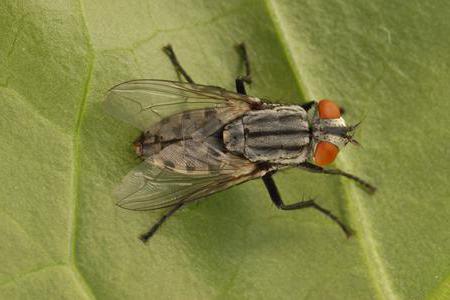

Such a fly prefers to lay its eggs in a moist, rotting environment, such as manure. One female can lay up to 120 eggs at a time, fortunately, not all offspring hatch.
| This is an article on entomology. You can help the project by supplementing it. |
K: Wikipedia: Articles without images (type: unspecified)
Gray meat fly
This fly is also called a sarcophagus. She is carrional. This is a large fly, its length reaches 25 millimeters.Gray meat flies have, as the name implies, a gray color with a darker pattern in the form of checkers or lines, with a yellowish-white head, "separated" by a black stripe. The eyes are red, with white longitudinal lines on the belly. The shape of the body is oblong, the abdomen is covered with large bristles, hairy legs.


Gray meat flies are rare guests in human dwellings and appear there only if they have something to profit from there. The sense of smell of these flies is very developed, and they are able to smell the smell of rotting meat at a very great distance. Moreover, they just need to touch the surface of the meat, so that many small worms immediately move on it.
Females of gray blowflies are viviparous and lay larvae mainly in carrion. But there are representatives of this family, the larva of which is capable of developing in rotting fruit, feces, or other decaying organic matter. There are also species of fly, the larvae of which are capable of parasitizing on other living organisms.
The larva of this fly is characterized by extraintestinal digestion. Sometimes she is able to feed on the larvae of other insects or practice cannibalism. The fly fly larva lives on carrion for up to 10 days, after which it moves into the soil, where it turns into a pupa, and then into an adult fly.
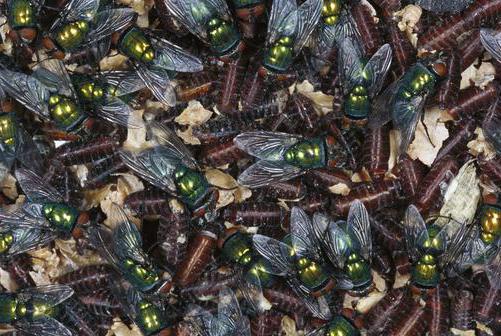

A meatfly pupa can hibernate, for example, pupae of some sarcophagus species are able to "sleep" all winter and turn into an adult only in late spring.
The meatfly feeds on the nectar of flowers, and at the same time pollinates them, transferring pollen on its shaggy legs.
The attitude to gray blowflies, as well as to other carrion species, cannot be unambiguous. Being carriers of infectious diseases, they also serve as a kind of orderlies in nature. And forensic forensic scientists are able to determine the time of death by the age of the larva in a decomposing corpse.
Benefit and harm
All types of meat flies pose an epidemiological danger to humans, since they live on decaying organic matter, corpses. They also eat there. They are mechanical carriers of pathogens - bacteria, viruses, parasites. The most dangerous disease is leprosy, the most common is intestinal infection.
Important!
Infection occurs by contact. Pathological microorganisms remain on the legs, the body of the insect. So from the feces, the meatfly lands on vegetables, fruits, meat, and any other product. Eggs enter the human body when hygiene rules are violated - unwashed hands, food. The larvae are especially dangerous as distributors of myiasis - helminthic invasion in animals and humans.
The meatfly brings a lot of harm to the fishery, laying eggs or larvae in lightly salted, fresh fish. The product loses its presentation, poses a threat to health and human life.
On the body of animals, where there are open wounds, females lay eggs, reproduce larvae. Attracted by the smell of rotting flesh, bacteria on damaged skin. In living flesh, worms make moves, feed, lead an active lifestyle.
In addition, the blowfly or carrion fly is extremely beneficial in helping the decay of corpses. This cleans the environment.
Interesting!
During the First World War, a unique property of blowflies was discovered. Maggots settled in wounds, ate rotting tissues and bones. The secretions of worms prevented the reproduction of pathogenic bacteria, which stopped inflammatory, decaying processes, and accelerated the process of wound healing. In medicine, this method of therapy is used for poorly healing wounds. But the worms are taken exclusively sterile, bred in laboratory conditions.
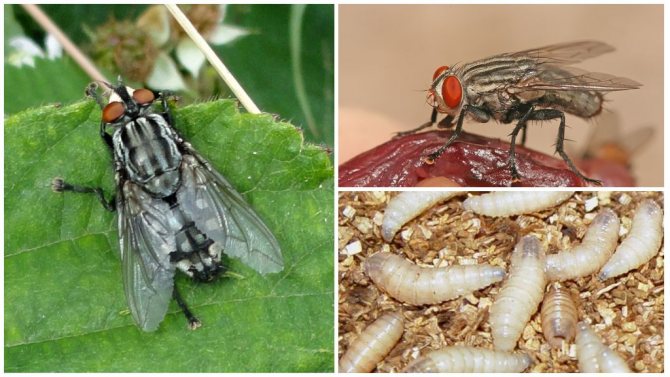

Meat fly
Green meat fly
This is a beautiful fly of glossy emerald color with smoky wings, which have a faint openwork pattern.The length of a green fly usually does not exceed 8 mm. Has large reddish eyes, a rounded abdomen and white cheeks.
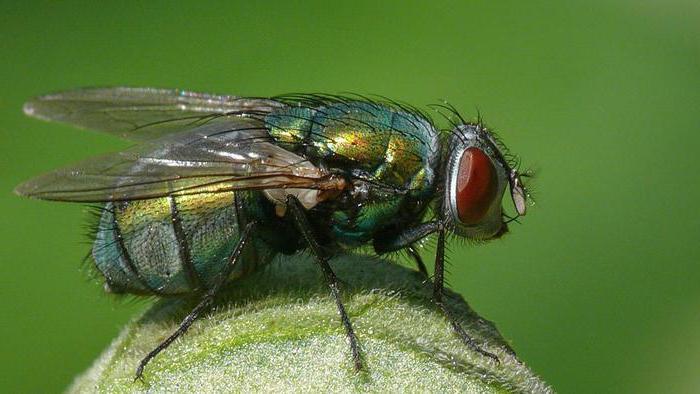

The habitat of the green meatfly is places of all kinds of sewage, decomposing animal corpses, manure, waste, but sometimes they are also found in flowering plants with a strong aroma. Food consists of rotting organic matter, where it lays its eggs.
One female is able to lay about 180 eggs of a grayish or light yellow hue, which she tries to hide in carrion as deep as possible. The larvae are born in 6-48 hours and continue to develop there for another 9 days. After that, they move into the soil to turn into a pupa. Depending on weather conditions, an adult fly takes 10-17 days to form.
Protective measures
The most successful in getting rid of flies can be considered those measures that are aimed at cleansing standard insect habitats:


- continuous disposal and destruction of waste on an industrial scale;
- neutralization of liquid waste in sewerage ponds or cesspools;
- observance of cleanliness in places of trade in meat and fish products;
- timely removal of household waste;
- chemical destruction of larvae and pupae in suspicious places;
- installation of mosquito nets on windows;
- washing hands before eating.
Fly larvae - application
White maggots, so popular among anglers, are exactly the larvae of the blowflies. Some fishing enthusiasts take them out on their own, laying out pieces of rotting meat. But many still prefer to buy them in the store, since such "farming" has a rather specific smell, which usually keeps people from such agricultural production.
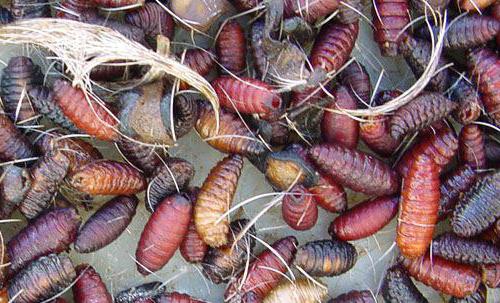

Classification of larvae
There are several types of maggots:
- Maggot are the larvae that are laid by the blue carrion fly. They develop in rotting meat or fish, and a few minutes are enough for the fly to fly to the smell. These maggots are 15 mm long.
- Gozzer is a larva of meat black-headed blue flies. Reaches up to 20 mm in size and very quickly passes into the pupal stage.
- Gordini - larvae of gray meat flies, grow up to 25 mm, pupate very quickly.
- Pinka is the larva of a green meatfly. Small maggots, no more than 10 mm in size.
- Fifa is the larva of the lucilia fly. Frost-resistant maggots no more than 12 mm long.
Description of appearance
The body structure of a green scavenger is similar to an ordinary fly, only the first is slightly larger. Its body length reaches 1.5 cm. The eyes look like large red spots that occupy a large area of the head. The back and abdomen are cast in an emerald sheen with golden tints. In the photo of a green fly, you can clearly see its bright color.
On a note!
The scavenger moves much slower than her counterparts. It is easier to catch or kill mechanically. Another difference between an insect and an ordinary fly is a significant hum during the flight, so you can immediately understand that a green carrion fly has flown into the house.
Fighting uninvited guests
A large fly buzzing under the ear can cause not only a comparative inconvenience, but also a carrier of a dangerous disease. They can infect both food and the infection directly into the blood of a person. Tuberculosis, typhoid fever, cholera are some of the diseases that flies can infect humans.
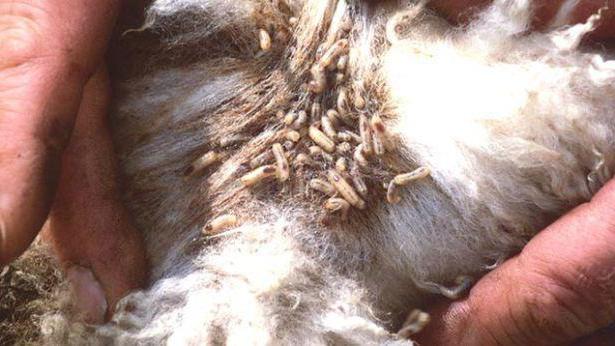

The main principle of dealing with them is to maintain cleanliness. After all, as already mentioned, flies perfectly feel the smell of food and fly towards it. Emptying the trash can regularly, cleaning up after pets, keeping food open, equipping windows with safety nets - these are some simple ways that can make a person's life much easier.
Indeed, despite how long the common fly lives, it is capable of giving us many problems even in its short life. Even without being a carrier of the disease, she can be very annoying, since she does not have enough discernment to understand that she is not welcome here and look for a quieter place. No matter how many times you chase her away, she will come back again and again.
In addition, flying around the room, she marks everything with her secretions. Scientists have calculated that one fly is capable of "checking in" at least fifty different places per day. And each of them is a real breeding ground for microbes. So in the fight against flies, the rule that "cleanliness is the guarantee of health" works like never before.
By the way, not only the blowfly, but also the small midge that bothers in the open air can also be the causative agent of serious diseases. It causes various conjunctivitis and is the cause of many intestinal diseases.
Prophylaxis
To combat blue flies, a person must carry out a number of preventive measures:
- take out the trash regularly;
- install garbage containers on special, asphalted sites;
- on livestock and poultry farms, it is necessary to equip sewage drains, concreting the floor;
- install mosquito nets on the windows.
It is impossible to provide complete protection against insects by preventive work alone. It is necessary to carefully clean the premises, use the existing means to destroy them:
- sticky tapes;
- traps;
- chemicals and folk remedies.
Emulsion larvicides are used to destroy pupae. For adults - well-known effective insecticides.
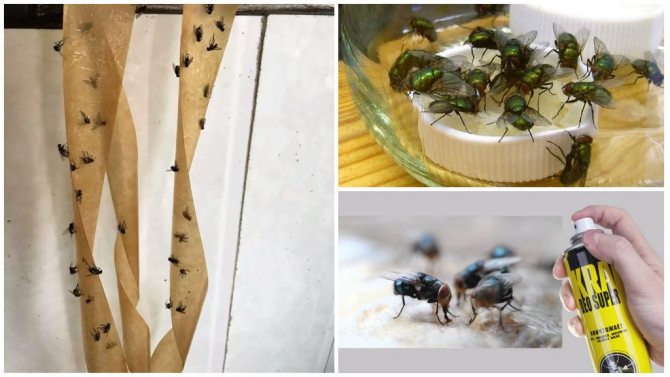

Fight against blue flies
Feedback
I do not know what flies fly into my house, but sometimes I paid attention to their color. There were bluish and greenish individuals. For protection, I most often use adhesive tape.
Natalia, Kursk


